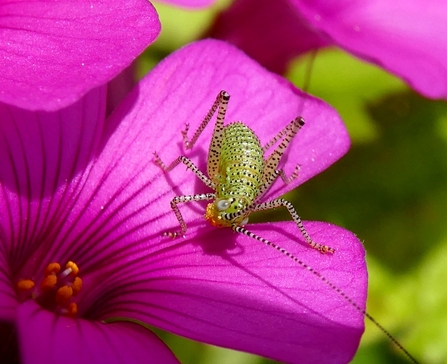The Royal Entomological Society estimates there are more than 24,000 known insect species in the UK. Many of them cannot be reliably identified without examination by a specialist, but others are fairly straightforward. Here are some you could get to know a little better.
Insects you can get to know this summer
James Adler
The Red-tailed Bumblebee (Bombus lapidarius) is probably the most easily recognisable bee. It’s one of the ‘Big 7’ abundant bumblebee species in the UK and can be found in a range of habitats, taking pollen from flowering plants. Both sexes have a furry black body with extensive bright red-orange ‘tail’, but the male is somewhat smaller and usually has additional bands of yellow hairs on the thorax, including a furry ‘collar’.
The male Swollen-thighed Beetle (Oedemera nobilis) is unmistakable
There are over 4,000 beetle species in Britain, but a male Swollen-thighed Beetle (Oedemera nobilis) is unmistakable. His enlarged thighs (femora) are obvious, and although the female doesn’t have this feature, both sexes have bright metallic green iridescence and tapering wing casings. All beetles have mouthparts adapted for chewing, and like many other beetles, this species is an excellent pollinator, moving between open flowers such as dandelions, buttercups, cow parsley and brambles.
Batman Hoverfly (Myathropa florea) with ‘bat’ markings on thorax
The ‘Batman Hoverfly’ (Myathropa florea) is on the wing from April to late October, and the pattern of light and dark ‘bat’ markings on the thorax are characteristic, along with bright yellow fuzzy hairs and robust build. It visits tree blossoms, umbellifers and bramble flowers, and in early autumn feeds on ivy blossom – an excellent late source of pollen and nectar for insects stocking up before the lean winter months.
Gatekeeper Butterfly (Pyronia tithonus) with two white spots in the black ‘eye’
The Gatekeeper butterfly (Pyronia tithonus) is usually around from late June to early September, flying on sunny days. The Meadow Brown (Maniola jurtina) can look very similar with wings closed, but they can be told apart via the black ‘eye’ spot on the forewings; the Gatekeeper has two white ‘pupils’ in the spot and the Meadow Brown has one.
A large and colourful shieldbug in a habitat with gorse or broom is likely to be the Gorse Shieldbug (Piezodorus lituratus). Bugs have mouthparts adapted for sucking liquids, and although this species can feed on a range of plants it causes very little damage. Mature adults have two colour forms - the spring generation is predominantly green-yellow, but summer individuals have additional purple and red markings. As with most shieldbug species the colours often become darker prior to hibernation.

Young nymph of the Speckled Bush-cricket (Leptophyes punctatissima) - already very distinctive
The Speckled Bush-cricket (Leptophyes punctatissima) has very long antennae, distinguishing it from grasshopper species that have short antennae. Adults can be seen between August and late October, and are mainly green with small black speckles and pale stripe along the back. Mature females have a large, upturned appendage (ovipositor) to lay eggs into plant stems or tree bark; the eggs develop over the winter months, with young nymphs emerging the following spring.
Speckled Bush-cricket (Leptophyes punctatissima)
Insect identification can be challenging as there are variations within individuals of the same species, and differences due to sex, stage of development and time of year - but whether or not you can name them, they will always be vital components of the natural world.
Find out how you can support our vital insects and pollinators below

